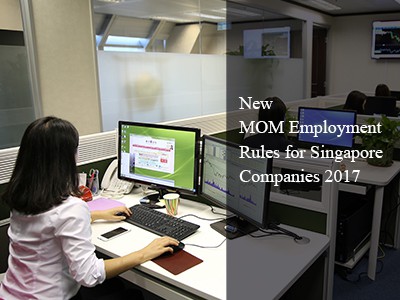New MOM Employment Rules for Singapore Companies From 1 January 2017
The recent announcement of MOM rules sees some new legislative changes. Among others, the increased paid paternity leave and mandatory retrenchment notification are the new changes that attract the public’s attention.
1. Increased Paid Paternity Leave

What is the eligibility?
a) The child should be a Singapore citizen born on or after 1 January 2017.
b) The Father is or had been legally married to the child’s mother between conception and birth. (Please note that the rule is applicable for adoptive fathers whose formal intent to adopt is on or after 1 January 2017.)
c) For employed father: The Father should have served his employer for a continuous period of at least 3 months before the birth of the child.
d) For self-employed father: He has been engaged in his work for a continuous period of at least 3 months before the birth of his child, and have lost income during the paternity leave period.
How to take the paternity leave?
a) Default (without any mutual agreement) – two continuous weeks within 16 weeks of the child’s birth.
b) Flexible (by mutual agreement)
- 2 continuous weeks any time within 12 months after the birth of the child, or
- Split the 2-week paternity leave into working days and take them in any combination within 12 months after the birth of the child.
c) Calculating actual leave days – 2 weeks X the number of working days in the week(A maximum of 6 working days per week)
2. Increased Shared Parental Leave
Beginning from July 2017, working fathers are entitled to shared parental leave up to 4 weeks of their wives’ 16 weeks of maternity leave. As of now, working fathers can share only one-week parental leave. This includes one week each of childcare and unpaid infant care leave respectively.
What is the eligibility?
a) The child is a Singapore citizen born on or after 1 July 2017.
b) The child’s mother qualifies for Government-Paid Maternity Leave (GPML).
c) The parents are lawfully married.
How to take shared parental leave?
a) Default (without any mutual agreement) – four continuous weeks within 12 months after the birth of the child.
b) Flexible (by mutual agreement)
- Split the 4-week parental leave into working days and take them in any combination within 12 months after the birth of the child.
c) Calculating actual leave days – 4 weeks X the number of working days in the week(A maximum of 6 working days per week)
3. Government-Paid Maternity Leave Benefit Extended to Unmarried Mothers
Another new legislative change is that unmarried mothers are now eligible for 16 weeks Government-Paid Maternity Leave.
What is the eligibility?
a) The child should be a Singapore citizen born on or after 1 January 2017.
b) For employed mother: The Mother should have served her employer for a continuous period of at least 3 months before the birth of the child.
c) For self-employed mother: She has been engaged in her work for a continuous period of at least 3 months before the birth of her child, and has lost income during the paternity leave period.
d) 1-week notice must be given to employer before going on maternity leave and informed as soon as possible of the delivery.
4. Increased Minimum Salary of Employment Pass
The salary qualifying criteria for Employment Pass (EP) applications has been increased from $3,300 to $3,600 in line with rising local wages. The change is part of the Ministry of Manpower’s regular updating of the criteria and it will take effect from 1 January 2017.
5. Mandatory Retrenchment Notifications
Beginning 1 January 2017, Singapore employers who employ at least 10 employees are required to notify MOM if five or more employees are retrenched within any six-month period. It is mandatory that employers must notify MOM within five working days for the first four retrenched employees, after the fifth employee is notified of retrenchment. Employer is subject to a fine penalty not exceeding $5,000 due to any noncompliance issue in the retrenchment notification.
6. Retirement and Re-employment Criteria (effective 1 July 2017)
Beginning 1 July 2017, employers must offer re-employment up to the age of 67. There will be new rules for re-employment by a different employer, with safeguards for employees.
Employees will be qualified for re-employment up to age 67 if he or she:
a) Is a Singapore citizen or Singapore permanent resident.
b) Has served his or her current employer for at least 3 years before turning 62.
c) Perform fairly good, as assessed by the employer.
d) Medically fit and physically healthy to continue working.
e) He or she was born on or after 1 July 1952.
Re-employment by a different employer:
In the case that an employer is unable to re-employ the employee, the employer can transfer re-employment obligations to another employer instead of paying the Employment Assistance Payment (EAP) to the employee.
Special Employment Credit (SEC)
Employers who voluntarily re-employ workers aged 65 and above will receive a wage offset of up to 8% of an employee’s monthly wages (wage capped at $3,000) under the Special Employment Credit(SEC). In other words, the SEC enhancement will help employers to manage their overall costs and encourage them to voluntarily re-employ workers aged 65 and above.








